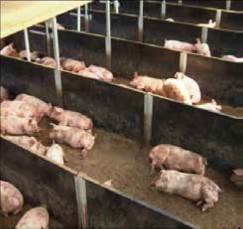Dunging in the lying area

What To Look For:
Pigs appearing dirty, presence of dung or urine in the lying area.
This suggests that the ventilation pattern does not match the pigs’ preferred behaviour pattern or pen layout (eg position of feeders and drinkers). If the ventilation system is not able to maintain a comfortable temperature and humidity in the lying area, pigs may choose to lie in the cooler dunging area. This then makes it more likely that they will dung in the previous lying area.
This pattern may also induce unsettled or irritable behaviour in the pigs as their resting behaviour is constantly disturbed.
Alternately, dung in the lying area can suggest that the dunging area is too small, or that pigs are trying to dung away from the feeders. It can also suggest that the dunging area is being avoided by the pigs, e.g. strong ammonia, or rain and wind.
Additional information:
Pigs appearing dirty, presence of dung or urine in the lying area.
This suggests that the ventilation pattern does not match the pigs’ preferred behaviour pattern or pen layout (eg position of feeders and drinkers). If the ventilation system is not able to maintain a comfortable temperature and humidity in the lying area, pigs may choose to lie in the cooler dunging area. This then makes it more likely that they will dung in the previous lying area.
This pattern may also induce unsettled or irritable behaviour in the pigs as their resting behaviour is constantly disturbed.
Alternately, dung in the lying area can suggest that the dunging area is too small, or that pigs are trying to dung away from the feeders. It can also suggest that the dunging area is being avoided by the pigs, e.g. strong ammonia, or rain and wind.
Suggestions:
- Check the daily (and nightly) ventilation patterns in the pen
- Cold air should be directed towards to the dunging area, with warmed air moving over the lying area
- Drinkers should be present near the dunging area as pigs may drink and defecate in the same area – this also reduces fouling of the lying area
- Whilst slatted flooring is designed to separate pigs from dung and urine, correct ventilation patterns should be used to help the pigs distinguish between pen areas, reducing soiling of pigs, pen humidity and disturbance to resting pigs
- If flooring is solid, ensure floor drains away from the lying area, consider additional drainage channels
- Move feeders away from dunging area
- Check stocking density for pen size and adjust if necessary
Additional material:
Using pig behaviour to optimise pen design
http://www.thepigsite.com/articles/928/using-pig-behaviour-to-optimize-pen-design/
Information about ventilating pig buildings: https://ahdb.org.uk/knowledge-library/ventilating-pig-buildings
AHDB ventilating pig buildings guide http://pork.ahdb.org.uk/environment-buildings/pig-buildings-housing-development/ventilation/ventilating-pig-buildings-guide/
Gadd, J. (2003). Pig Production Problems: A Guide to their Solutions. Nottingham University Press.
